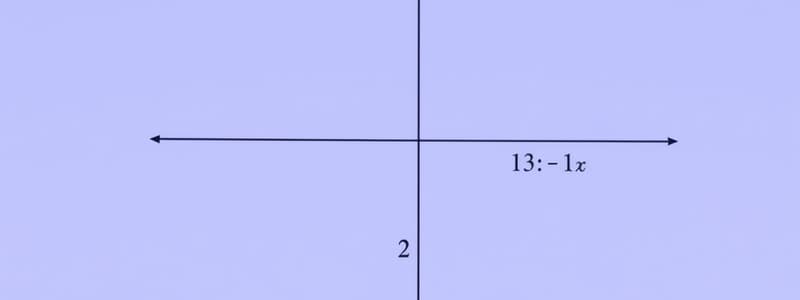Podcast
Questions and Answers
What is the correct notation for the left-hand limit of a function at point c?
What is the correct notation for the left-hand limit of a function at point c?
- $ ext{lim}_{x o c} f(x)^{-}$
- $ ext{lim}_{x o c^+} f(x)$
- $ ext{lim}_{x o c^-} f(x)$ (correct)
- $ ext{lim}_{x o c} f(x)$
Which of the following best describes the condition for the application of L'Hôpital's Rule?
Which of the following best describes the condition for the application of L'Hôpital's Rule?
- Both numerator and denominator must have non-zero limits
- The function must be continuous everywhere
- The limit must be an indeterminate form like $ rac{0}{0}$ or $ rac{ ext{infinity}}{ ext{infinity}}$ (correct)
- The limit must equal 0 or $ rac{1}{0}$
When considering the limit of a function as x approaches infinity, which of the following factors is most relevant?
When considering the limit of a function as x approaches infinity, which of the following factors is most relevant?
- The behavior of the function near zero
- Checking for rational roots
- The degree of the numerator and denominator in rational functions (correct)
- Finding the derivative of the function
What does the limit $ ext{lim}_{x o c} f(x) = - ext{infinity}$ imply about the function f(x)?
What does the limit $ ext{lim}_{x o c} f(x) = - ext{infinity}$ imply about the function f(x)?
Which property allows you to separate the limit of a product into the product of the limits?
Which property allows you to separate the limit of a product into the product of the limits?
What condition must be satisfied for a function to be considered continuous at a point c?
What condition must be satisfied for a function to be considered continuous at a point c?
Which of the following special limits evaluates to 1?
Which of the following special limits evaluates to 1?
What is the limit as x approaches c for the polynomial function $f(x) = 3x^2 - 4x + 7$?
What is the limit as x approaches c for the polynomial function $f(x) = 3x^2 - 4x + 7$?
Flashcards are hidden until you start studying
Study Notes
Limits
Definition of Limits
- A limit describes the behavior of a function as the input approaches a certain value.
- Notation: ( \lim_{x \to c} f(x) = L ) means as ( x ) approaches ( c ), ( f(x) ) approaches ( L ).
Types of Limits
-
One-Sided Limits
- Left-Hand Limit: ( \lim_{x \to c^-} f(x) )
- Right-Hand Limit: ( \lim_{x \to c^+} f(x) )
-
Infinite Limits
- ( \lim_{x \to c} f(x) = \infty ) indicates that ( f(x) ) increases without bound as ( x ) approaches ( c ).
- ( \lim_{x \to c} f(x) = -\infty ) indicates that ( f(x) ) decreases without bound.
-
Limits at Infinity
- ( \lim_{x \to \infty} f(x) ) examines the behavior of ( f(x) ) as ( x ) approaches infinity.
Properties of Limits
- Sum/Difference Rule: ( \lim_{x \to c} [f(x) \pm g(x)] = \lim_{x \to c} f(x) \pm \lim_{x \to c} g(x) )
- Product Rule: ( \lim_{x \to c} [f(x) \cdot g(x)] = \lim_{x \to c} f(x) \cdot \lim_{x \to c} g(x) )
- Quotient Rule: ( \lim_{x \to c} \frac{f(x)}{g(x)} = \frac{\lim_{x \to c} f(x)}{\lim_{x \to c} g(x)} ) (if ( g(c) \neq 0 ))
Techniques for Finding Limits
-
Direct Substitution
- Substitute ( c ) directly into ( f(x) ).
-
Factoring
- Factor and simplify the expression, then substitute.
-
Rationalization
- Multiply by the conjugate to eliminate radicals.
-
L'Hôpital's Rule
- Use when encountering indeterminate forms like ( \frac{0}{0} ) or ( \frac{\infty}{\infty} ).
- Take the derivative of the numerator and the denominator.
-
Special Limits
- ( \lim_{x \to 0} \frac{\sin x}{x} = 1 )
- ( \lim_{x \to 0} \frac{1 - \cos x}{x^2} = \frac{1}{2} )
Continuity
- A function is continuous at ( c ) if:
- ( f(c) ) is defined.
- ( \lim_{x \to c} f(x) ) exists.
- ( \lim_{x \to c} f(x) = f(c) )
Common Limit Forms
- Polynomial Functions: Limits of polynomials as ( x \to c ) yield direct substitution.
- Rational Functions: Analyze degrees of numerator and denominator for behavior at infinity.
- Trigonometric Functions: Use special limits and periodic properties.
Summary
Limits are foundational in calculus, enabling the understanding of continuity, derivatives, and integrals. Mastery of limits and their properties is essential for success in AP Calculus.
Definition of Limits
- Describes the behavior of a function as the input approaches a certain value.
- Notation: ( \lim_{x \to c} f(x) = L ) means ( f(x) ) approaches ( L ) when ( x ) approaches ( c ).
Types of Limits
- One-Sided Limits:
- Left-Hand Limit: ( \lim_{x \to c^-} f(x) ) examines behavior from the left.
- Right-Hand Limit: ( \lim_{x \to c^+} f(x) ) examines behavior from the right.
- Infinite Limits:
- ( \lim_{x \to c} f(x) = \infty ): ( f(x) ) increases without bound as ( x ) approaches ( c ).
- ( \lim_{x \to c} f(x) = -\infty ): ( f(x) ) decreases without bound.
- Limits at Infinity:
- ( \lim_{x \to \infty} f(x) ): Studies the behavior of ( f(x) ) as ( x ) approaches infinity.
Properties of Limits
- Sum/Difference Rule: ( \lim_{x \to c} [f(x) \pm g(x)] = \lim_{x \to c} f(x) \pm \lim_{x \to c} g(x) ).
- Product Rule: ( \lim_{x \to c} [f(x) \cdot g(x)] = \lim_{x \to c} f(x) \cdot \lim_{x \to c} g(x) ).
- Quotient Rule: ( \lim_{x \to c} \frac{f(x)}{g(x)} = \frac{\lim_{x \to c} f(x)}{\lim_{x \to c} g(x)} ) if ( g(c) \neq 0 ).
Techniques for Finding Limits
- Direct Substitution: Substitute ( c ) directly into ( f(x) ).
- Factoring: Factor expressions then simplify before substituting.
- Rationalization: Multiply by the conjugate to remove radicals.
- L'Hôpital's Rule: Apply for indeterminate forms ( \frac{0}{0} ) or ( \frac{\infty}{\infty} ) by differentiating the numerator and denominator.
- Special Limits:
- ( \lim_{x \to 0} \frac{\sin x}{x} = 1 ).
- ( \lim_{x \to 0} \frac{1 - \cos x}{x^2} = \frac{1}{2} ).
Continuity
- A function is continuous at ( c ) if:
- ( f(c) ) is defined.
- ( \lim_{x \to c} f(x) ) exists.
- ( \lim_{x \to c} f(x) = f(c) ).
Common Limit Forms
- Polynomial Functions: Direct substitution yields limits of polynomials as ( x \to c ).
- Rational Functions: Analyze degrees of numerator and denominator for limits at infinity.
- Trigonometric Functions: Use special limits and properties of periodicity.
Summary
- Limits are critical in calculus, laying the groundwork for concepts like continuity, derivatives, and integrals.
- Understanding limits and their properties is crucial for academic success in AP Calculus.
Studying That Suits You
Use AI to generate personalized quizzes and flashcards to suit your learning preferences.




